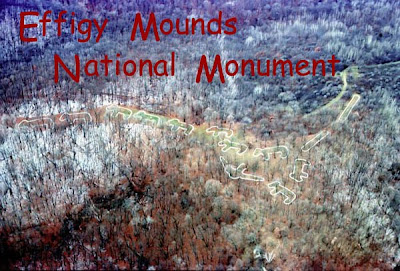For too many people, the term "Indian mound" conjures up a mental image of a crude pile of dirt used as a burial site. This is egregiously unfortunate, because most such mounds were not in fact burial sites - a misunderstanding that has led to so many of them being (fruitlessly) plundered for nonexistent artifacts.
The best native American mounds were "effigy mounds" crafted in the shape of animals or symbols for religious or ritual purposes. The geometric mounds may be linear or conical, but the most striking ones depict birds and animals. Many of them are frankly hard to detect at eye level when you walk through a woods, and can be easily overlooked. There are a number of them within the grounds of the University of Wisconsin Arboretum that are passed by daily by dozens of wildflower-seeking hikers totally unaware that the mounds are even there, much less that they are culturally significant.
I was reminded of this topic when a friend sent me a link to the image above showing a series of bear mounds (and a bird and two linears) at Effigy Mounds National Monument in Iowa. What is most clever about the photo is how the mounds were outlined; the staff at the center waited for a minor snowfall and then simply raked the snow off the crest of the mounds to outline the figures!
For several years I've been a member of a Wisconsin organization called Cultural Landscape Legacies, which works to educate people about and to preserve the cultural heritage of Wisconsin's indigenous people. Several times a year - typically in the spring before the mosquitoes get too bad - we will go out in work crews to do maintenance work on ancient earthworks, typically along the Wisconsin River. I would encourage those of you who have an interest in matters like this to check with your local historical society to locate groups in your area where you can volunteer your time for this purpose; it's a significantly rewarding activity.
Photo credit.

I am part of a contemporary mound-building culture. At several Pagan gatherings over the past 10-12 years I have participated, with much sweat and dirty labor, in the constriction of two mounds. Both were created, and consecrated, in ritual ceremony. One was a small ancestor mound, dedicated to the ancestors, and a recently deceased member of the intentional community reclaiming the land (an abandoned strip mine). It contained trinkets of significance to the members of the core community. The second was in the shape of a turtle. It is perhaps 25 feet long by 12-15 feet wide. The bulk of the body is built up with boulders and smaller rock (thus the sweat), then filled in - again in a ritual manner - with dirt by some 250 people at the gathering. There is nothing of monetary value entombed, merely things of spiritual importance to those who constructed it.
ReplyDeleteI have a degree in archaeology, and while I was in school, we worked on a dig at a giant shell mound on a lake in Florida. Turned out to be an old Paleoindian ritual site with an adjacent habitation site. It was very interesting!
ReplyDeleteVery few mounds are actually burial sites. Even most of the ones WITH burials aren't burial SITES... they were often from cultures with very few afterlife rituals and the bodies of the dead were just thrown out with the garbage, basically.